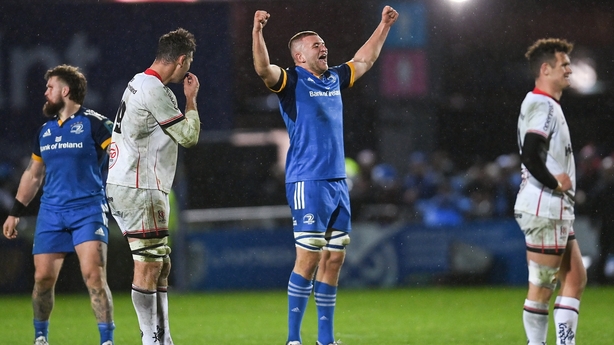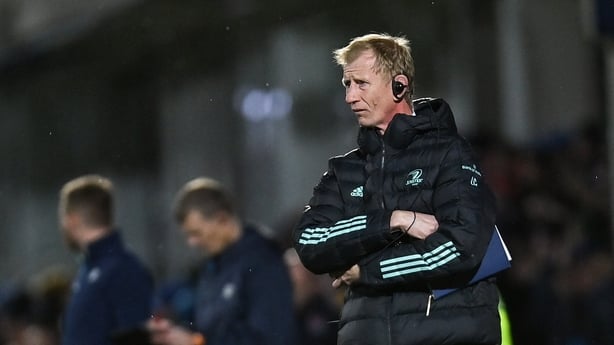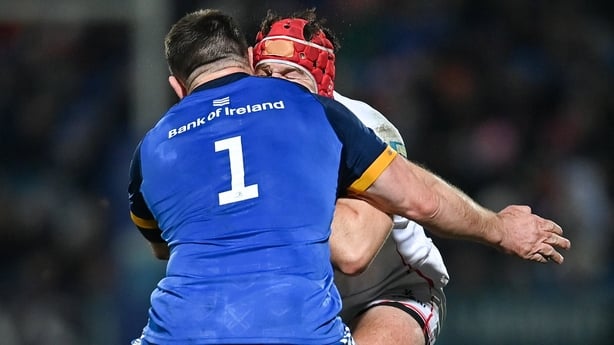Leinster overcame a huge challenge last weekend as they came from 19 points down to beat Ulster with only 14 players for three quarters of the match.
Losing a player is hugely difficult. It upsets many aspects of play and Leinster took nearly the whole second quarter of the game to come to terms with it.
Cian Healy showed true professionalism when receiving the red card - taking his medicine without complaint. There was no intent behind his high tackle on Tom Stewart. There was plenty of intent to stop the Ulster hooker breaking from the maul, which we see him doing so often, but Healy did try to lower his height, he just got the collision wrong and was rightly sent off.
Eddie O'Sullivan and Darren Cave analysed how Leinster overcame Cian Healy's dismissal and a 19-point deficit to defeat Ulster and maintain their 100% start
Red cards challenge a coach's ability to think on the spot. There’s always a consequence in terms of attacking and defensive structures. However, when you lose a prop there’s the added decision as to who else you need to sacrifice because once the next scrum happens you will need to take a player off the reinstate a full front row.
You can’t play the game without a scrum, and therefore Andrew Porter came on and it was Jimmy O’Brien that was called ashore.
The carded player isn’t only responsible for their own early exit from the game in this instance. It’s not great from a coaching perspective to be forced to decide which player to lose either.
The decision to take Jimmy O’ Brien off surprised me considering his recent form but you only get a minute or two on the sideline to weigh up your options here and it’s important that you make the right one. The common replacements would be to take off a back row player or a back three player. There are pros and cons with both.

Defensive structures are the hardest piece of the jigsaw. If you take away a back three player, you will leave more room to cover in the back field. Nowadays, teams regularly defend with only two players in the back field anyway and Leinster use Gibson-Park on the edges so they could have sacrificed a player from the back three positions without causing too much disruption.
However, it meant that their front line defence would still be a man short, but such is life when playing with a red card.
Similarly, if you lose a forward, you limit your defensive structures around the set piece. It means you would have to scrummage a man short or put a back into the back row if the scrum struggled. Leinster would have known the power of the Ulster maul and therefore chose to sacrifice a back instead.
It depends on where the opposition strengths lie. Leinster may have felt that Ulster’s main attacking threat comes from their attacking maul and therefore needed a full complement of forwards to stop that. Despite keeping eight forwards on the pitch, Leinster still struggled to contain the Ulster forward power in the second quarter.
There are some set-piece starter plays that need a full back line too. That is why Josh Van Der Flier had to cover the wing for the first scrum that was played after the sending off.
"The tactical battle of being down a player for the set piece is an interesting one, but one that no coach will enjoy at the time."
There was a blind side on Leinster’s left-hand side so they backed their remaining forwards to hold the scrum and use their flanker in a winger’s position. If they left eight forwards scrummaging and brought an open side back across, then the open side would have been vulnerable too.
Leinster could have opted to close up the full back and winger harder but with the 50:22 law in place, they could easily have been caught on the kick.
Van Der Flier was facing Ethan McIlroy and despite the world player of the year being well able to hold his own in defence, a dangerous runner like McIlroy will still cause him trouble.
Subsequently, Gibson-Park over chased in his defensive role to double tackle McIlroy and Billy Burns took full advantage by dummying his pass to McIlroy and breaking through the defence before Ross Byrne’s high, scrambling tackle.

The red card directly affected Leinster in this sequence and as a coach you’d be scratching your head as to what to do. The Leinster scrum held Ulster with seven players so maybe that decision was justified, but would they then have been better with a winger instead of a flanker?
The Stewart Moore try also came from Leinster being down a winger. Jack Conan was the widest defender for Leinster with no winger covering across. McIlroy and Moore combined to scorch down the left-hand touchline.
I would have thought that Leinster would split their back field cover to favour both touch lines, but then Ulster may opt for long territorial kicks down the middle of the pitch. It’s very hard to know which aspect to cover and which defensive frailties you might be willing to deal with. It’s like a game of chess when you’re down a piece and pre-empting the next move, the opposition is in full control.
Will Connors, Ian Madigan and Malakai Fekitoa spoke to RTÉ Sport ahead of the opening round of this season's Heineken Champions Cup
Leinster’s attack would also have suffered from the red card. If you take away a forward, your maul threat becomes less because you have less power and numbers to go after the opposition. Even in the back line, the opposition can put an extra forward inside their out-half to widen their defence and double up in midfield to stop any of the opposition powerful runners.
When you lose a back, your strike plays become less potent because the blind side winger often acts as the second line of attack which is what forces decisions from the opposition backs. It’s more likely that they would keep swapping the back three players to make sure a blind side winger is in place for attacking strike plays. However, you then lose width on the outside.
There’s no way around it, losing a player for 60 minutes is a serious blow. However, Leinster found a way to overcome it after the initial disruption.

The man of the match display from replacement prop Andrew Porter, helped a lot. So too did the dazzling footwork of Garry Ringrose and the Leinster pressure forcing Ulster to play with 13 players during the second half following two yellow cards of their own.
The tactical battle of being down a player for the set piece is an interesting one, but one that no coach will enjoy at the time.
Leinster and Leo Cullen will take great satisfaction from being able to turn it around ahead of a big weekend ahead in European action. This will strengthen their connections as a group and bodes well for them in the weeks ahead.


